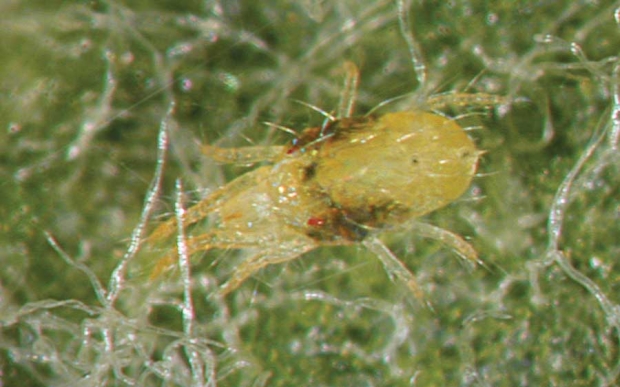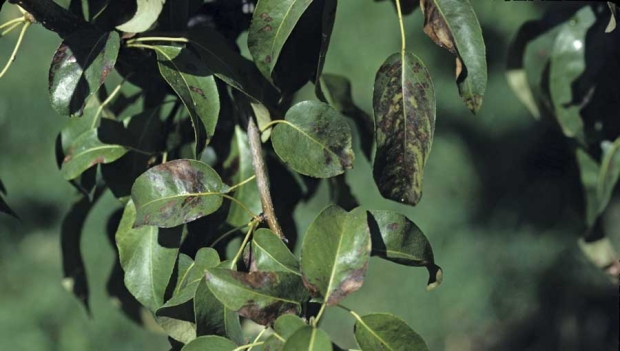
A view of an adult female two-spotted spider mite. (Courtesy Dr. Elizabeth Beers)
The days of simply spraying the two-spotted spider mite may be waning, even with six miticides available to control them.
Dr. Elizabeth Beers advises pear growers to start talking to their chemical representatives about some other way to keep the pests at bay, because the mites are building resistance to nearly all chemicals currently labeled for control.
The two-spotted spider mite pierces the leaves and sucks out the juices. The mite also attacks apples, hops, vegetables and many other crops. Pear leaves, however, are more sensitive to mite damage than apple leaves, developing black patches on leaves called transpiration burn when combined with water stress.
Anjou pears are the most at risk, showing symptoms more quickly than others. Beers called them the “canary in the coal mine” cultivar.
“We are getting sort of toward the end of our rope,” said Beers, a research entomologist at the Washington State Tree Fruit Research and Extension Center in Wenatchee, Washington.
A history of miticides
Pest resistance to chemical controls has been common knowledge for a century. In fact, a WSU researcher named A.L. Melander first documented the concept that insects develop tolerance for sprays with a 1914 paper in the Journal of Economic Entomology.
Growers have learned to work around resistance by rotating between two or three different chemicals year to year.
In fact, some modern pesticide labels allow for only one application a season.
Pear growers, like everyone else, have faced the resistance problem for decades, burning through a list of 24 or more miticides since World War II. In recent years, however, growers appeared to have it good, with six different chemicals labeled for mite control — Agri-Meck (abamectin), Acramite (bifenazate), FujiMite (fenpyroximate), Envidor (spirodiclofen), Onager (hexythiazox) and Zeal (etoxazole).
“Six seemed liked a luxurious number by comparison to what we’ve had in the past,” Beers said.
However, at the request of one of the companies, FujiMite, Beers tested all over the West Coast for resistance and found high levels of resistance in one sample population in central Washington’s Wenatchee Valley.
Meanwhile, field representatives and growers in the area had been sharing anecdotal observations that miticides weren’t working as well as they used to.
“That had us scratching our heads,” she said.
Growing resistance

Damage from two-spotted spider mite shows up as transpiration burn on pear leaves. (Courtesy Dr. Elizabeth Beers)
In 2013, Beers started a two-year research project comparing the resistance level of all six miticides, funded by a $48,310 research grant from the Washington State Tree Fruit Research Commission.
For her study, she collected 700 female spider mites from four Washington orchards in Chelan, Douglas, Okanogan and Yakima counties, put them on a bean leaf and applied increasing doses of miticides.
The mites showed resistance to all but one: Envidor, an ovicide and the most recently labeled of the six chemicals.
Onager and Zeal also are ovicides, the rest are adulticides. Among the five remaining chemicals where resistance is an issue, the level increased by statistically significant amounts — up to 127,000 times the resistance of a control group from Cornell University, reared for 15 years with no pesticide exposure at all.
The mites developed higher levels of resistance to the adulticides than to the ovicides. They showed the most resistance to Agri-Mek, not surprisingly the oldest of the six chemicals, used in pears since the late 1980s. In second came Acramite.
“Agri-Mek and Acramite are predicted to provide little control in the field,” Beers said, though Agri-Mek maintained some efficacy in a field near Yakima, where resistance was lower.
The resistance buildup could spell drastic changes for growers trying to control mites. “It’s thrown a serious wrinkle into our thinking about resistance management,” she said.
Complicating the problem is that many of the sprays used for mites also work on psylla. In fact, attempts to control psylla largely caused the mite problems, she said.
Beers suggests the industry start looking for “soft” methods of pest control, including relying on natural predators to help. Other than that, she admits she has no magic prescription.
“I don’t have any silver bullets for the growers, and I’m sorry to say that,” she said. •
– by Ross Courtney






Leave A Comment